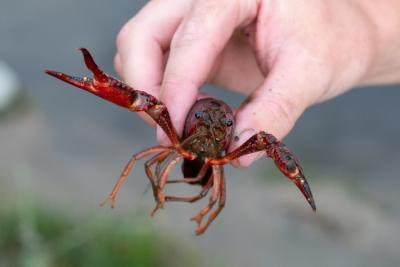Originally from the southeastern U.S., the red swamp crayfish has become an unwelcomed world traveler. These invasive crayfish are highly aggressive and mobile. Here in the U.S., they are commonly spread by unsuspecting aquarium-hobbyists or biology teachers releasing the unwanted pet into their backyard ponds and rivers.
In 2017, the red swamp crayfish initially found its first Michigan home in a hotel retention pond. The Michigan Department of Natural Resources spent three years trapping and removing more than 100,000 crayfish from the pond without reaching eradication. Michigan has been trying to control booming populations of invasive red swamp crayfish for six years, and intensive efforts have only made a dent in their numbers.
U.S. Fish and Wildlife Service is partnering with Michigan DNR, Michigan State University, Auburn University and the U.S. Geological Survey to develop invasive crayfish control technologies. Serving as a hub for innovative eradication techniques, the GLRI-funded partnership creates a direct research-to-management pathway.
Efforts to control red swamp crayfish have included daily trapping, filling burrows, sound baiting, biological predation control, and X-ray sterilization, among other efforts. All these approaches take a significant amount of time, money and scientific expertise. The team is excited to be developing techniques that bypass trapping and culling all together. They hope to find the most efficient and effective methods of management.
If red swamp crayfish numbers were to spiral out of control, their effects would be devastating to our waters. Red swamp crayfish are more aggressive than native crayfish, outcompeting them for food and space. The invasive is quick to disperse and has more stamina to travel. Furthermore, unlike native species, the invasive’s burrowing habits are so intense they can collapse underground infrastructure as the sediments supporting piping shift and erode. Their burrows form unwanted drainage from wetlands.


